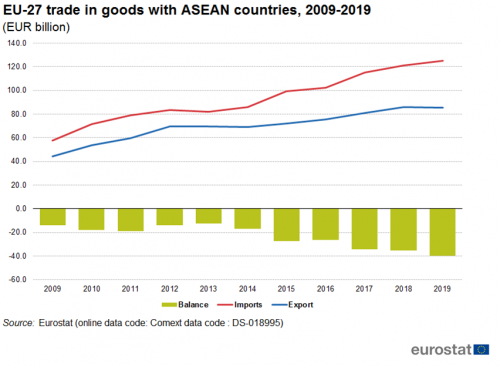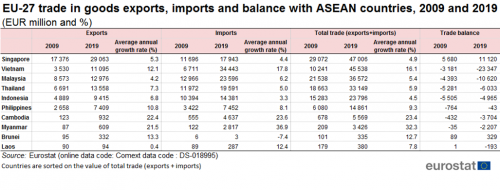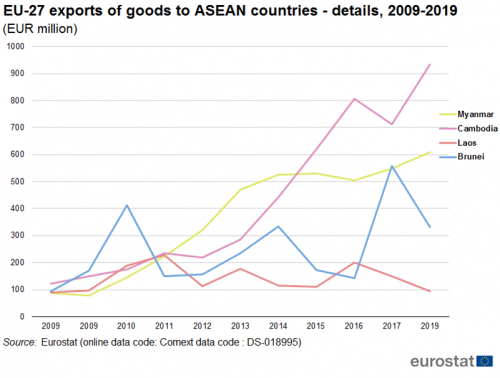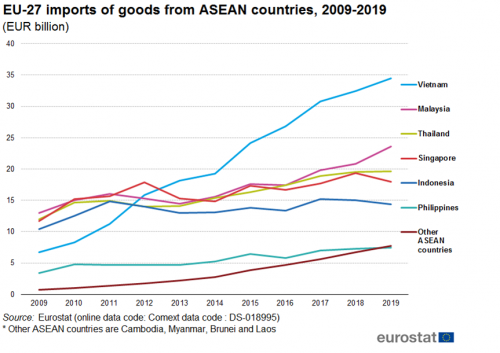Archive:ASEAN-EU - international trade in goods statistics
Data extracted in April 2020
Planned article update: May 2021
Highlights
Manufactured goods dominated EU trade with ASEAN partners in 2019, with 84 % of total exports and 87 % of total imports.
Singapore was the largest ASEAN destination for EU exports of goods in 2019, while Vietnam was the largest ASEAN partner for EU imports of goods.
Germany was the largest EU exporter of goods to ASEAN countries in 2019, with €28 billion while the Netherlands was the largest importer of goods from ASEAN countries with a value of €30 billion.
EU-27 trade in goods: Imports, exports and trade balance with ASEAN countries, 2009-2019
This article provides a picture of the international trade in goods between the European Union (EU) and ASEAN. It analyses the type of goods exchanged between them and the shares of each EU Member State in those exchanges. The countries belonging to ASEAN are Brunei, Cambodia, Indonesia, Laos, Malaysia, Myanmar, the Philippines, Singapore, Thailand and Vietnam.
This article is part of an online publication providing recent statistics on international trade in goods, covering information on the EU's main partners, main products traded, specific characteristics of trade as well as background information.
Full article
ASEAN countries trade in goods with main partners
The six largest trade in goods partners of ASEAN countries are shown in Figure 1. Between a fifth and a quarter of imports and exports of ASEAN countries is with other ASEAN countries. In both cases China and the EU are the second and third largest partner respectively. For exports, the next three largest partners are the United States, Japan and Hong Kong, and for imports the next three are Japan, the United States and South Korea.
EU-27 trade with ASEAN countries continues to be in deficit
Between 2009 and 2014, total EU imports and exports of goods of ASEAN countries have a similar pattern: a low point in 2009 followed by a strong recovery (see Figure 2) which flattens between 2012 and 2014. Throughout this period, the trade deficit fluctuated between EUR 12 billion and EUR 20 billion. After 2014, imports from ASEAN countries grew more strongly than exports and consequently the trade deficit grew to EUR 40 billion in 2019.

(EUR billion)
Source: Eurostat - Comext DS-018995
Manufactured goods dominate trade with ASEAN partners
In 2009, 87 % of goods exported to ASEAN countries were manufactured goods (see Figure 3). This share fell to 84 % in 2019, while the share of primary goods rose from 10 % in 2009 to 14 % in 2019. The declining share for manufactured goods was caused by the decline in the share of machinery and vehicles from 54 % in 2009 to 48 % in 2019.

(shares of total exports in value)
Source: Eurostat - Comext DS-018995
Manufactured goods also dominate imports of goods from ASEAN countries (see Figure 4). Between 2009 and 2019 their share increased from 79 % to 87 % due to the increasing share of machinery and vehicles and of other manufactured goods. The seven percentage points (pp) drop in the share of primary goods was caused mainly by the falling share of raw materials, although the shares of both other categories also fell.

(shares of total imports in value)
Source: Eurostat - Comext DS-018995
Singapore largest ASEAN destination for EU exports of goods
Table 1 shows the exports, imports and trade balance for trade in goods between the EU and ASEAN countries. In 2019 total trade (exports + imports) of the largest two trade partners Singapore (EUR 47 billion) and Vietnam (46 billion) were quite close. However total trade with Vietnam grew three times as fast as total trade with Singapore between 2009 and 2019.

(EUR million and %)
Source: Eurostat - Comext DS-018995
Figure 5 shows the EU exports of goods to the six largest ASEAN trading partners (Singapore, Thailand, Malaysia, Vietnam, Indonesia and the Philippines). Singapore is the largest export destination for EU exports of goods and also had the largest increase in exports from EUR 17.4 billion in 2009 to EUR 29.1 billion in 2019. This EUR 11.7 billion increase equates to an average annual growth rate of 5.3 %. Much higher average annual growth rates were seen for exports to Vietnam (12.1 % and the Philippines (10.8 %). Among the smaller countries, Cambodia (22.4 %), Myanmar (21.5 %) and Brunei (13.3 %) also had double-digit growth rates, as shown in Figure 5b.

(EUR billion)
Source: Eurostat - Comext DS-018995

Source: Eurostat - Comext DS-018995
Vietnam largest ASEAN partner for EU imports of goods
The EU's largest partner for imports of goods among ASEAN countries in 2019 was Vietnam. The growth from EUR 6.7 billion in 2009 to EUR 34.4 billion in 2019 was equivalent to an average annual growth rate of 17.8 % (Figure 6). It thereby surpassed the imports from Indonesia, Thailand, Malaysia and Singapore whose average annual growth rates varied between 3.3 % and 6.2 %. The Philippines had the second largest growth rate (8.1 %) among the larger ASEAN countries. Among the smaller ASEAN countries, Cambodia (23.6 %) and Myanmar (36.9 %) (Figure 6b) achieved even higher growth rates than Vietnam, coming from absolute values that were below EUR 1 billion in 2009.

(EUR billion)
Source: Eurostat - Comext DS-018995

Source: Eurostat - Comext DS-018995
Vietnam's high growth in imports meant that the EU saw its trade in goods deficit with Vietnam increase from EUR 3 billion in 2009 to EUR 23 billion in 2019 (see Figure 7). The trade deficit with Malaysia also increased significantly. With the exception of Brunei (0.3 billion) and Singapore (+ 11.1 billion), the EU had trade deficits with all ASEAN countries.

(EUR billion)
Source: Eurostat - Comext DS-018995

Source: Eurostat - Comext DS-018995
Germany largest trade in goods partner for ASEAN countries
The largest EU exporter of goods to ASEAN countries in 2019 was Germany. German exports of goods to ASEAN countries had a value of EUR 28 billion, making up 4.4 % of all their extra-EU exports. This share was highest in Malta where 14.9 % of extra-EU exports was destined for ASEAN countries.

(EUR million and %)
Source: Eurostat - Comext DS-018995
Among the EU Member States, the Netherlands with EUR 30 billion was the largest importer of goods from ASEAN countries followed closely by Germany with EUR 29 billion. In Austria (11.3 %) and Slovakia (10.3 %) more than 10 % of imports originated from ASEAN countries.

(EUR million and %)
Source: Eurostat - Comext DS-018995
There were seven Member States that had a trade in goods surplus with ASEAN countries in 2019. The highest surplus (EUR 4 billion) was recorded by France. Twenty Member States had trade deficits with ASEAN countries. The largest were observed in the Netherlands (EUR 21 billion), Belgium (EUR 6 billion) and Spain (EUR 4 billion).

(EUR million)
Source: Eurostat - Comext DS-018995
Source data for tables and graphs
Data sources
EU data is taken from Eurostat's COMEXT database. COMEXT is the reference database for international trade in goods. It provides access not only to both recent and historical data from the EU Member States but also to statistics of a significant number of third countries. International trade aggregated and detailed statistics disseminated via the Eurostat website are compiled from COMEXT data according to a monthly process.
Data are collected by the competent national authorities of the Member States and compiled according to a harmonised methodology established by EU regulations before transmission to Eurostat. For extra-EU trade, the statistical information is mainly provided by the traders on the basis of customs declarations.
EU data are compiled according to Community guidelines and may, therefore, differ from national data published by the Member States. Statistics on extra-EU trade are calculated as the sum of trade of each of the 27 EU Member States with countries outside the EU. In other words, the EU is considered as a single trading entity and trade flows are measured into and out of the area, but not within it.
The United Kingdom is considered as an extra-EU partner country for the EU-27 for the whole period covered by this article. However, the United Kingdom was still part of the internal market until the end of the transitory period (31 December 2020), meaning that data on trade with the United Kingdom are still based on statistical concepts applicable to trade between the EU Member States. Consequently, while imports from any other extra-EU-27 trade partner are grouped by country of origin, the United Kingdom data reflect the country of consignment. In practice this means that the goods imported by the EU-27 from the United Kingdom were physically transported from the United Kingdom but part of these goods could have been of other origin than the United Kingdom. For this reason, data on trade with the United Kingdom are not fully comparable with data on trade with other extra-EU-27 trade partners.
Data from the perspective of ASEAN (as used in figure 1) is based on statistics from UNCTAD, combining data from UN Comtrade, IMF, Eurostat, UNCTADstat and UNCTAD secretariat calculations.
Methodology According to the EU concepts and definitions, extra-EU trade statistics (trade between EU Member States and non-EU countries) do not record exchanges involving goods in transit, placed in a customs warehouse or given temporary admission (for trade fairs, temporary exhibitions, tests, etc.). This is known as ‘special trade’. The partner is the country of final destination of the goods for exports and the country of origin for imports.
Product classification Information on commodities exported and imported is presented according to the Standard international trade classification (SITC). A full description is available from Eurostat’s classification server RAMON.
Unit of measure Trade values are expressed in millions or billions (109) of euros. They correspond to the statistical value, i.e. to the amount which would be invoiced in case of sale or purchase at the national border of the reporting country. It is called a FOB value (free on board) for exports and a CIF value (cost, insurance, freight) for imports.
Context
Trade is an important indicator of Europe’s prosperity and place in the world. The block is deeply integrated into global markets both for the products it sources and the exports it sells. The EU trade policy is an important element of the external dimension of the ‘Europe 2020 strategy for smart, sustainable and inclusive growth’ and is one of the main pillars of the EU’s relations with the rest of the world.
Because the 27 EU Member States share a single market and a single external border, they also have a single trade policy. EU Member States speak and negotiate collectively, both in the World Trade Organization, where the rules of international trade are agreed and enforced, and with individual trading partners. This common policy enables them to speak with one voice in trade negotiations, maximising their impact in such negotiations. This is even more important in a globalised world in which economies tend to cluster together in regional groups.
The openness of the EU’s trade regime has meant that the EU is the biggest player on the global trading scene and remains a good region to do business with. Thanks to the ease of modern transport and communications, it is now easier to produce, buy and sell goods around the world which gives European companies of every size the potential to trade outside Europe.
Direct access to
- International trade in goods (t_ext_go), see:
- International trade in goods - long-term indicators (t_ext_go_lti)
- International trade in goods - short-term indicators (t_ext_go_sti)
- International trade in goods (ext_go), see:
- International trade in goods - aggregated data (ext_go_agg)
- International trade in goods - long-term indicators (ext_go_lti)
- International trade in goods - short-term indicators (ext_go_sti)
- International trade in goods - detailed data (detail)
- EU trade since 1988 by SITC (DS-018995)
- International trade in goods statistics - background
- International trade in goods (ESMS metadata file — ext_go_esms)
- User guide on European statistics on international trade in goods
- European Commission
